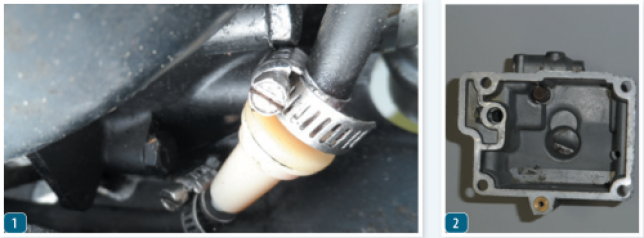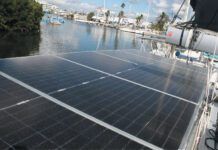
1. To ensure clean fuel we added a mower filter on our 3.5 horsepower Mercury. This motor had only an in-tank strainer and required annual cleaning. The mower filter also clogged every year or two, but was easier to clean or, if needed, cheap to replace.
2.This carburetor bowl shows with visible pitting. This motor clogged regularly until I switched to Biobor EB and added a vent filter. Then it was good for 10 years straight.
This year, President Trump rescinded the summer ban on E15 sales. Previously, E15 could not be sold between June 15th and September 1st because the extra ethanol increased vapor pressure and increased smog formation. As of this writing, distribution of E15 is limited outside of corn belt areas, and negotiations continue between the EPA, which opposes higher ethanol blend levels, and the agribusiness lobby.
We talked to a number of marine engine manufacturers to get the skinny and to learn if there was anything specific we should do. The answer was a uniform use only E10 or less. Higher mixtures are not EPA or manufacturer approved for small engines, outboards, or any marine engines.
Because ethanol contains oxygen and has a lower fuel value per gallon, ethanol gasoline blends require a richer mixture to burn properly. Automobiles use oxygen sensors, computer algorithms, and fuel injection to adjust to the fuel. However, the simple carburetor on your outboard can’t do this and, as a result, the engine runs lean.
Despite cautions against it, we tried E15 in a test engine, because thats what we do. It made the engine idle fast, causing an audible klunk when we shifted, increasing the likely hood of hub, and shear pin failures. Testing by the National Renewable Energy Lab documented that when engines were run hard for extended periods, the exhaust gasses were 20 F hotter, valve wear increased, and pistons softened. Elastomers were also observed to degrade more quickly. There is nothing an additive can do to solve these problems.
Phase Separation. Like E10, E15 is hygroscopic and draws water. Fuel with 5 percent ethanol becomes unstable when they contain 0.2 percent water. E10 separates when it contains 0.4-0.6 percent, a level that in the absence of a leak, is difficult to reach. With E15 this increases to 0.6-0.8 percent water, making separation quite unlikely. Its counter intuitive, but more ethanol makes for a more stable blend. But irrelevant since you can’t use it.
Just avoid it.

































